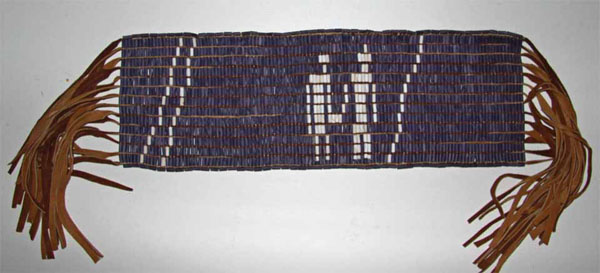Photographs (left to right): Trumpet Plants; Imperial Sand Dunes; Ridgecrest; all California
Wampum Belt Archive
Delaware

Royal Ontario Museum HD 6354/2

Wm Penn 1662 Belt
Reproduction R. D. Hamell June 24 2016
Original Size: |
Length: 17.3 inches. Width: 5 inches. 117 vertical rows by 13 high. 1521 beads |
Reproduction: |
Beaded length: 19 inches by 6 inches wide. |
Beads: |
117 rows by 13 high. Two horizontal rows top and bottom. 1,745 beads |
Materials: |
Warp: leather. Weft: Artificial sinew. |
Description:
Purple beads made from saltwater shells strung on a fibre thread form the background of the belt. This wampum belt features two figures in the center, a Native and a non-Native (with hat) clasping hands. Also shown are two parallel diagonal lines worked in white beads. Wampum strung on fiber thread. This belt is finished with a strip of fur at each end. ROM assigned its age as being from the 16th to 18th Century.
At the ends of the belt is fur (species?). The top and bottom warp outside edge has a horizontal row of purple beads. The is a second partial row on the bottom right.
This image was also found on the STUDYBLUE web site with the caption as a Delaware Belt depicting William Penn with a Delaware Chief, be it a rough 'negative image' of the William Penn-Delaware Belt of 1662 shown below.

Author's note: the presence of diagonal lines supports an Iroquoian affiliation. Other characteristics of this belt should be detailed.
The first characteristic which struck me as unusual is the ends are edged with fur (fox?). 2) the top and bottom edges are lined with the beads lying horizontally, not totally odd since the Great White Belt is done so).
Close examination of the diagonals and figure legs to determine missing beads were the cause of the 'discoloration' found the beads used were highly variegated (poor quality) and sections of individual rows are comprised
of 2 shorter beads. This combination of sizes contributed to the distortion of the images and diagonals. This 'abnormalities' brought to my mind "is it a composite beaded belt using beads collected from different time periods?"
Stolle, Nickolaus (2016): Ex Oronhyatekha Coll., acquired from Chief Waubuno (John P. Wampum) at Munceytown in 1887.
Reference:
Stolle, Nickolaus. 2016. Talking Beads: The history of wampum as a value and knowledge bearer, from its very first beginnings until today. Hamburg, Germany. ISSN 1437-7837
Royal Ontario Museum
 |
 |
 |
 |
 |
 |
 |
 |
|---|